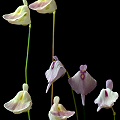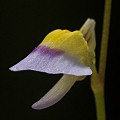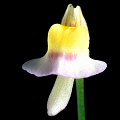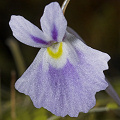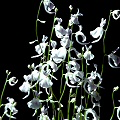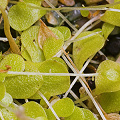| Utricularia section Calpidisca | ||
|---|---|---|
| Species | Range | Habit1 |
| U. arenaria | Asia, Africa | T |
| U. bisquamata | Africa | T |
| U. brachyceras | Africa | T |
| U. firmula | Africa | T |
| U. livida | Africa, Latin America | T |
| U. microcalyx | Congo, Zambia | T |
| U. odontosepala | Africa | T |
| U. pentadactyla | Africa | T |
| U. sandersonii | South Africa | T |
| U. troupinii | Rwanda, Burundi | T |
| U. welwitschii | Africa | T |
| 1T=terrestrial. | ||
Q: About Utricularia subgenus Bivalvaria section Calpidisca
A: Some of the species in this secion are the most commonly cultivated in the world. They are, for
the most part, a group of terrestrials that are extremely easy to grow in standard tropical cultivation conditions. Indeed, some
of these are so easy to grow and are so prolific, they are considered weeds in cultivation and are banned from many collections.
Given 1/10th of a chance they will invade every pot in your collection, displacing the harder to grow dainties you
may be slaving to cultivate.
This section has a number of technical characters that group them; Taylor points out that the section can actually be fairly
neatly divided into two subgroups (based upon the trap door of the traps) but did not wish to separate them into separate
sections.
Ellison & Adamec (2018) chose not to include the species Utricularia brachyceras
or U. odontosepala.
Utricularia arenaria
This little critter is extremely similar to
Utricularia livida; the distinguishing character easiest to use is that its spur is about twice
as long as the lower corolla lobe (as opposed to only about 1.5 times as long). If that admittedly weak character fails you,
you must to look for
little tiny bumps (papillae) on the base of the flower stalk---I have had to rely on this microscopic character a couple of times.
Utricularia bisquamata
Beware, as this is one of the weeds I was telling you about. Most of the clones
in cultivation--the ones you are most likely to receive as an unknown hitchhiker in purchases of other carnivorous plants--are
extremely prolific via seed, and they get everywhere. Unfortunately, the flowers are usually very small and boring, too.
However, a rare form in cultivation has much larger and more colorful flowers, and it is not a weedy-seedy monster.
This clone, sometimes labeled "Betty's Bay", is very nice. The photo to the right is a highly magnified
image of one of the small forms.
Utricularia brachyceras
Taylor considered this to be a synonym of Utricularia bisquamata, but Fleischmann pulled it out of the dustbin.
Utricularia livida
This plant is highly variable, and many forms can be found in cultivation.
Part of this variability is due to its range---in addition to Africa, it also occurs in Mexico and other Latin American countries.
While remarkable, this species is not the only plant in the genus with such a range:
Utricularia pubescens and U. simulans have comparable distributions.
Utricularia pentadactyla
As Taylor coyly notes in his monograph, this is the first of the
species in the genus that he described---and he described more than fifty! I have seen this plant listed as occurring in many
carnivorous plant collection inventories, but every one I have inspected turned out to be an incorrectly identified
specimen of Utricularia biquamata. Note that U. pentadactyla has
a lower corolla lip that is mildly to deeply divided into five lobes.
Utricularia sandersonii
Ah, the most commonly grown species in even this group,
U. sandersonii is a real charmer. In most conditions, as soon as the plant fills its pot with little
leaves, it begins a huge and flamboyant flowering display. There is some floral variation in the clones in cultivation, and
some are given names like "blue", but they have not been described as cultivars. Peter D'Amato sometimes calls this species
the "bunny-faced bladderwort", and I can certainly see why! For more on the cultivation of this species, you can see
an ancient paper I wrote in 1994.
Page citations: Fleischmann, A. 2015; Rice, B.A. 1994e; 2006a; Taylor, P. 1989; personal observations.
